|
I have always liked Ruger bolt action
rifles, but never loved Ruger bolt action rifles. From the
beginning since the introduction in 1967 of the Model 77,
they have been rugged, reliable, and accurate enough for
hunting. The Ruger was a very good design, with its
flat-bottomed receiver and angled receiver bolt anchoring it to
the stock. The lines were classic, without the white-line
spacers and Monte Carlo cheek pieces that were popular in that
era. Thankfully, it wore real cut checkering, while most of its
competition used machine pressed checkering that looked as if it
had been designed by some second-grade school kid. Then around
1989 a few changes were made and the Model 77 Mark II was born.
It was a bit trimmer, wore a different safety, and was or was
not an improvement upon the original design, depending upon whom
you asked. It had a better safety and cleaner lines, and
was offered in more configurations than ever. I never disliked
the Ruger bolt guns at all, but I never bought one either,
preferring their single shot Number One rifles instead.
Part of that could be that for many years, Ruger never offered a
left-handed bolt action, and that is the way that I am wired. Bill
Ruger himself told me once, to my great disappointment,
that Ruger would most likely never make a left-handed bolt gun,
as the market just wasn’t there. Thankfully, Ruger does now,
as has for a few years, offered left-handed bolt guns, in a
limited selection of rifles and chambered for a select few
cartridges. They also never had been extremely accurate, as a
group. They were perfectly serviceable for their intended
purpose, they just didn’t usually produce the kind of groups
that you cut out and carry around in your pocket to show your
friends. The Ruger Model 77 rifles are, and always have been,
very good rifles, they just failed to excite me very
much…….until now.
A few months ago, I heard that Ruger was
introducing a slightly redesigned rifle called the Hawkeye.
Being a rifle shooter and jack-leg gun writer, I was interested.
When I also heard that they were introducing a new .375
cartridge along with it, I became very interested. I have always
been a fan of the legendary .375 Holland & Holland
Magnum, and knew that if Ruger had the nerve to challenge that
grand old cartridge, I wanted to see for myself. After seeing a
photo of the new Hawkeye African, I was elated. I had seen the
pictures, read the specifications of both the rifle and
cartridge, (Hornady claimed that its numbers equaled or
bettered the .375 H&H Magnum, even from a shorter
twenty-inch barrel), and wanted to see for myself if the
performance was there, and if the accuracy would make the
Hawkeye African as special as it looked.
Let's start right there, with the looks of the
new rifle. After a couple of agonizing months awaiting the
Hawkeye to go into production, I finally got the call that the
rifle had arrived at Brigham Hardware in Dover,
Tennessee. Brigham’s is one of those hardware stores that is
still the way a hardware store should be. It is family owned,
carries hardware, tools, lumber, sand, roofing, plumbing
supplies, well pumps, and among a world of other
stuff…….firearms. Shotguns, rifles, handguns, ammunition,
and most of the stuff needed to go along with them. It is like
all hardware stores used to be, and its kind is quickly
disappearing. Anyway, I got the call and headed to town.
Aesthetically, the Hawkeye African is one of the best looking
rifles, to my eyes, that Ruger has ever made; almost as handsome
as their Ruger Magnum Rifles, but at half the retail
price, and with a weight savings of over two pounds.
The Hawkeye African wears a beautiful stock made
of real American walnut, just as God intended. The forearm is
slender, and has cut checkering all around. The pistol
grip is graceful and trim, is finished with a blued steel grip
cap, and the buttstock has clean, straight lines. The rifle
wears a good, soft recoil pad, which is a very nice improvement.
The blued steel is a semi-matte finish, and the one-piece
bolt/handle is made of stainless steel. The magazine floorplate
is made of blued steel, (I checked it with a magnet just to be
sure) and has a machine-cut Ruger logo on its surface. The
sights are both functional and aesthetically pleasing; the wide
V rear sight mated to the large bead on a ramped barrel band
front just looks right on a rifle of this type. Also, the stock
crossbolt, while placed there for strength, adds to the handsome
classic appearance of the African.
The African wears a medium-weight twenty-three
inch long barrel that measures .667 inch at the muzzle. The
stock has front and rear sling swivel studs, as should every
hunting rifle. The magazine floorplate is released by pressing a
latch inset into the front of the trigger guard, and it works
perfectly. It takes a concerted effort to drop the floorplate.
It never drops open from recoil, and is not in a position to be
accidentally released. Like all Ruger centerfire rifles, the
heavy duty receiver has integral scope mounts, and Ruger
supplies every rifle with a set of steel scope rings, which is
another added value to Ruger rifles.
The African has Ruger’s new LC6 trigger, which
is an improvement over previous Ruger hunting rifle triggers. It
released crisply with no take-up or overtravel at a weight of
just over four pounds. I like a trigger a bit lighter for bench
work, but it is a very good field trigger as is. Chambered for
the new .375 Ruger cartridge, the African holds three in the
magazine in addition to the one in the chamber. The African has
a controlled-round feed system, and the huge extractor is as
tough as they come. The bolt works smoothly, with no sign
of binding, which is very important on a rifle built for hunting
the world’s most dangerous game. Also meant for dangerous
work, the rear sight does not fold down. It is a very rugged
unit, is drift adjustable for windage, and is quick to get on
target.
As stated earlier, Hornady claims more
performance than the .375 H&H, but from a standard length
action. The .375 Ruger case is the same length as the .30-06 and
similar cartridges, so it will work through Ruger’s standard
length action, with no need to use the longer, heavier magnum
length action. Also as mentioned earlier, the Hawkeye African
weighs significantly less than their .375 H&H Magnum rifle.
The magnum is listed at ten pounds, while the test rifle weighed
in at just over seven and three-quarters pounds, 7 pounds 12.6
ounces to be exact, unloaded and without a scope. Some consider
this to be too light for a .375 dangerous game rifle. I do not.
Adding a scope, sling, and ammunition adds about another one and
three-quarters pounds to the rifle, minimum. That brings the
total ready-to-go weight up to nine and one-half pounds. At that
weight, the African has plenty of heft, but is not so heavy as
to become unbearable to carry all day as would a heavier rifle.
Years ago, the great African hunters did not mind a fourteen
pound rifle, as they had gun bearers to do the rifle packing,
just taking hold of it long enough to make the shot. Me, I have
no gun bearer available, and must, like the common man, carry my
own rifle. I do not want to carry a twelve or fourteen pound
rifle. The price of lower weight is heavier felt recoil.
However, the African is not made for dove hunting, and a hunter
will most likely fire half a dozen or fewer shots on even a good
day afield. I also fired the African without a scope attached,
and even at just seven and three-quarters pounds, the recoil is
not punishing at all. I find the recoil of the big .300 magnums
to be much more painful than either this .375 Ruger or the .375
H&H magnum. Recoil velocity is very important in felt
recoil, and the thirty caliber magnums seem to recoil much
quicker, or sharper, than do these .375s. We took a video to
demonstrate the recoil of the Hawkeye African. Looking at the
short video clip, you can see that the recoil is more of a big
push than a sharp hit. In the video, the Ruger was fired with
Hornady’s 270 grain factory load, which clocks from this rifle
at 2758 feet-per-second (fps), at twelve feet from the muzzle,
which calculates to 2767.9 fps at the muzzle. Firing from a
standing position, the recoil did not hurt at all. Long sessions
at the bench are a totally different story, however.
I received the rifle before Hornady got the
production going on the ammunition, but I was able to get a set
of Hornady dies, and someone at Ruger acquired ten empty
cartridge cases for me, so I proceeded to work up loads for the
.375 Ruger. I had absolutely zero load data on the cartridge,
but knowing that the case capacity was a bit larger than that of
the .375 H&H magnum, that is where I started. The case is
similar in capacity to the .375 Dakota, but it is not the same
case. The capacity falls between the .375 H&H and the .375
Weatherby cases. I worked up loads slowly, judiciously measuring
case head expansion with a micrometer after each firing, and
also watching for primer pocket expansion and sticky extraction.
I at first hesitated to list any of the loads that I found to
work well in the .375 Ruger, but I will with the warning to the
reader that none of these loads have been pressure tested by me
nor anyone else. They proved to be safe in the test rifle, and I
did not try to push for the highest possible velocity. My
goal was to see if the new cartridge could indeed exceed the
performance of the beloved .375 H&H, and do so safely, which
it certainly did. In all loads listed here, extraction was very
easy, and the bolt could be retracted with one finger. Bolt lift
was easy. Case head expansion did not grow at all after the
initial firing. Primer pockets remained tight. However, once
again, I do not know how these will perform in your rifle, and
you would be wise to back off a few grains, and put in the
effort to work up to a safe level in your individual rifle.
Reliable load data will be available soon from the powder and
bullet companies, and I am sure that Hornady will share some
data if you need it before published data is available.
All loads tested were done so on a cold few
days, with temperatures ranging from eighteen to thirty-six
degrees Fahrenheit. Chronograph readings were taken with a PACT chronograph set at a distance of twelve feet from the
muzzle. To keep things as simple as possible, I used only CCI
large rifle magnum primers, and three Hodgdon powders:
H4350, H414, and Varget. These three powders will nicely cover
any weight of bullet made for the .375 Ruger, and offer
excellent performance. If I had to pick one powder for this
cartridge, it would be H4350, without hesitation. It is an
extremely stable extruded powder, and increases in powder charge
resulted in predictable and linear increases in muzzle velocity.
With H4350, it is hard to get into trouble with this cartridge,
as with every load listed, it filled the case well, and adding
more powder would result in the bullet having no room to be
seated. I like it. Overall cartridge length is dictated by both
the magazine length, and the bullet’s relation to the rifling.
I did not seat any bullets out long enough that they engaged the
rifling. Listed cartridge length for the .375 Ruger is 3.430
inches, with a maximum of 3.40 inches. Bullet and powder
weights are listed in grains. Velocities are listed in
feet-per-second. Cartridge overall length (OAL) is listed in
inches.
| Bullet |
Powder |
Charge |
OAL |
Velocity |
| Hornady 225 SP |
H414 |
90 |
3.41" |
3068 |
| Hornady 225 SP |
H4350 |
86 |
3.41" |
2938 |
| Hornady 225 SP |
H4350 |
88 |
3.41" |
3019 |
| Hornady 225 SP |
H4350 |
89.7 |
3.41" |
3100 |
| Hornady 270 SP |
H4350 |
85 |
3.413" |
2783 |
| Hornady 270 SP |
H4350 |
86 |
3.413" |
2828 |
| Hornady 270 SP |
H4350 |
87 |
3.413" |
2875 |
| Hornady 300 FMJ |
H4350 |
84.7 |
3.349" |
2782 |
| Barnes 210X |
Varget |
76 |
3.297" |
2965 |
| Barnes 210X |
Varget |
78 |
3.297" |
3029 |
| Barnes 210X |
H414 |
88 |
3.346" |
3085 |
| Barnes 235 XLC |
H4350 |
88.2 |
3.361" |
2940 |
| Barnes 235 XLC |
H414 |
88 |
3.351" |
2970 |
| Barnes 270 XLC |
H414 |
86.1 |
3.357" |
2975 |
| Barnes 270 TSX |
H414 |
86.1 |
3.331" |
2856 |
| Barnes 300 TSX |
H4350 |
84.7 |
3.366" |
2757 |
| Sierra 200 JRN |
H414 |
87 |
3.16" |
3032 |
| Sierra 200 JRN |
H414 |
88.2 |
3.16" |
3055 |
| Sierra 200 JRN |
Varget |
85.2 |
3.16" |
3300 |
| Hornady 270 SP (Factory Load) |
|
|
|
2758 |
NOTE: All load data posted on this
web site are for educational purposes only. Neither the author nor
GunBlast.com assume any responsibility for the use or misuse of this data.
The data indicated were arrived at using specialized equipment under
conditions not necessarily comparable to those encountered by the
potential user of this data. Always use data from respected loading
manuals and begin working up loads at least 10% below the loads indicated
in the source manual.
Accuracy testing with the African was done at
both 50 yards with the open sights, and at 100 yards with a
scope sight. With the Hornady 270 grain Spire Point factory
loads , the open sights were dead on at fifty yards, and that
was my reasoning for shooting with them at that range. I wanted
to determine their impact point, and fifty yards is the perfect
range for which to regulate them. I congratulate Ruger for doing
so. Out any farther than that, and I want a scope. When I first
heard of the .375 Ruger African, my one and only consideration
for a scope is also the one that I choose for a .375 H&H
rifle; the Leupold VX-II 2 to 7 x33. This scope is perfectly
sized in both power and physical dimensions to the African
rifle. It is perfect for both the cartridge and the game with
which it will likely be hunted. It has wonderfully long eye
relief, which is always a plus on a rifle that backs up a bit
when the trigger is pulled. I like a low powered scope in brushy
areas, as it allows the hunter to pick a clear spot in the brush
through which to shoot accurately. While the Ruger comes
equipped with an excellent set of rings, I chose to use the
superb Warne quick release rings. They attach with a
lever on each ring, and quickly detach without tools if the need
for the open sights arises. They also reattach quickly with no
discernable change of impact. I believe that they are the ideal
rings for such a versatile rifle. Some might try to pigeonhole
the .375 Ruger into a dangerous game only role, and that would
be a mistake. It is also an excellent choice for large deer such
as elk and moose at longer than normal range. The .375 Ruger,
with the proper bullet, shoots as flat as a .270 Winchester and
flatter than the .30-06, and hits a lot harder than either when
it gets there. The cartridge also exceeds its goal of
duplicating the .375 H&H magnum. Again, the loads listed
above were safe in my test rifle, and no other, unless you work
up the loads from starting data for the .375 H&H magnum
yourself. I did not try to go farther, though with a few of the
bullets listed, I believe that I could. There is nothing to be
gained in killing power by adding more speed, and very little to
be gained in trajectory. My goal was not to exceed Hornady
factory .375 Ruger loads. When working up these loads, the
factory ammunition had not yet arrived, and all of these were
developed using the ten once-fired cases that were sent to me.
No cases were lost due to firing. I bulged one trying to seat a
bullet over too much H4350, and another I stuck in the sizing
die and ripped the rim off of it. I had it very well lubed, or
at least I thought that I did. Apparently, I was wrong. Had I
already chronographed the factory loads, I would have stopped
load development after reaching their velocity, as Hornady has a
huge ballistics laboratory and an engineering staff to pressure
test this stuff, while I use a cruder form of estimating
pressure.
There are many excellent bullets available for
the .375 Ruger cartridge, and it is easy to match the bullet to
the game. The lighter stuff should be ideal on whitetail. The Sierra
200 grain bullet throttled back to about 2500 fps would be a
very good, mildly-recoiling load for such use. Any of the Barnes
X bullets, whether they be the plain shank, Triple-Shock, or XLC
would serve quite well where both expansion and deep penetration
are desired. The reliable Hornady bullets have proven themselves
worldwide in the .375 H&H magnum, and they have a suitable
bullet for any sized game. Other fine .375 bullets are available
from Woodleigh, Nosler, Speer, and several others.
I was both surprised and delighted with the
accuracy of this new Ruger. The day was cold, my fingers numb,
the rifle was dirty, and a wind was blowing, but thankfully it
was a steady wind at my back. The first 100 yard three shot
group measured .747 inch. The next three shot group
measured .6095 inch. I believe that if I could have held
steadier, the Ruger would have placed them all into the same
hole! The rifle fired this same way for several more groups,
until I had emptied that box of ammo. I made no effort at all to
develop an accuracy handload for the Ruger, as time did not
allow. I wanted to get the information published on Gunblast as
soon as possible, as I have many anxious readers wanting
information on the new rifle and cartridge. There has been a bit
of information in the press about the new cartridge, but mostly
just stuff gleaned from press releases thus far. The two groups
pictured were both fired with Hornady factory 270 grain Spire
Point ammunition, and were representative of the wonderful
accuracy exhibited by the test rifle. As I further develop
handloads for this rifle, it will be with the goal of adding
versatility to the bullet selection available to me. I do not
expect to best the accuracy of that Hornady factory ammunition
in this rifle. I have varmint rifles that do not shoot this
well.
My original plan was to review this rifle and
send it back to Ruger, waiting for the left-handed version that
is due out later this year. However, this one is so beautifully
accurate, that I believe that I will be sending a check instead.
I cannot recommend a rifle more highly than that.
Check out the full line of Ruger products
here.
For the location of a Ruger dealer near you,
click on the DEALER LOCATOR icon at: www.lipseys.com.
To see more details on the bullets used in load
development, go to: www.barnesbullets.com,
www.sierrabullets.com,
and www.hornady.com.
For more information on ammunition, components,
and dies for the .375 Ruger, go to: www.hornady.com.
View the extensive line of fine Leupold optics
at: www.leupold.com.
To order the Warne quick detachable rings, go
to: www.brownells.com.
To view the versatile line of Hodgdon powders,
go to: www.hodgdon.com.
The .375 Ruger Hawkeye African exceeded my
expectations. Ruger bolt action rifles are getting better all
the time, and I have finally found one that I love.
Jeff Quinn
|
To locate a dealer where you can
buy this gun, Click on the DEALER FINDER icon at: |
|

|
  
Got something to say about this article? Want to agree (or
disagree) with it? Click the following link to go to the GUNBlast Feedback Page.
|
|
Click pictures for a larger version.

Ruger’s New Hawkeye African .375 Ruger.
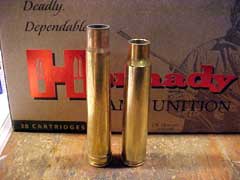
Cartridge case comparison: .375 H&H Magnum (left),
.375 Ruger (right).
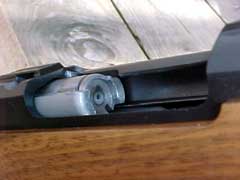
The Ruger's bolt features a huge claw extractor for
reliable feeding and extraction.
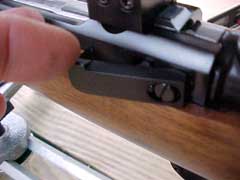
Bolt stop is located on the left-hand side of the
action.

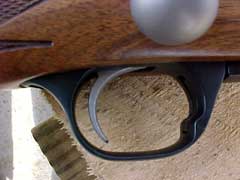
Steel magazine floorplate is embellished with the Ruger
logo (top). Floorplate release is well-located inside the
trigger guard (bottom).
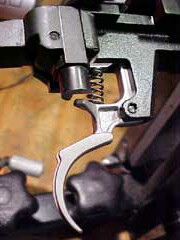
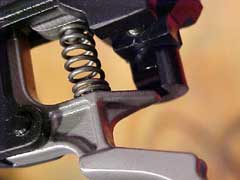
Ruger's new LC6 trigger is a great improvement over
earlier versions.
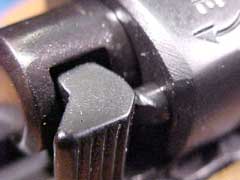
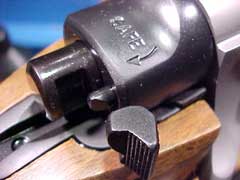

Three-position safety is rugged ad positive.
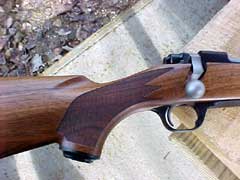
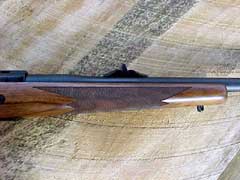
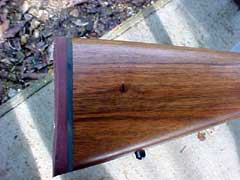
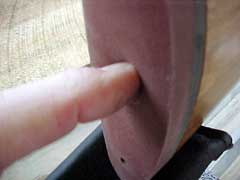
The beautiful American walnut stock is nicely-checkered
and well designed for use with iron sights or optics. The soft
rubber recoil pad is definitely appreciated.
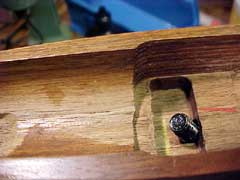
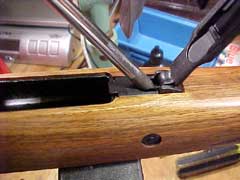
Angled receiver screw secures the action to the stock.
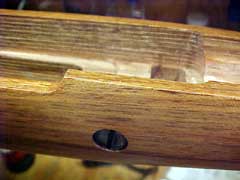
The stock also features a crossbolt for added strength.
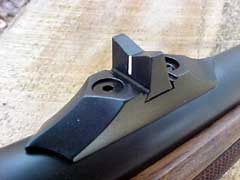

Iron sights are rugged, easy to see, and perfectly
regulated.
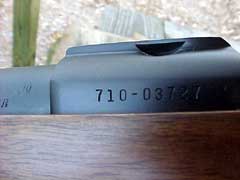
Scope base is integral, adding to its strength.
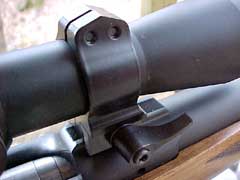
Warne detachable scope rings, available from Brownell's,
are the perfect choice for a rifle of this type.
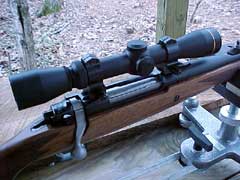
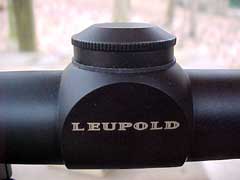
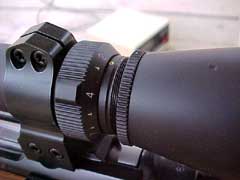
Jeff's first and only choice for a scope was Leupold's
VX-II 2 to 7 x33 variable.
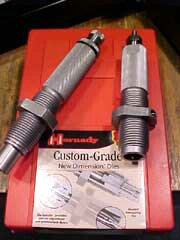
Loading dies for the .375 Ruger are available from
Hornady.

Author tested the Ruger using a variety of bullets. Left
to right are: Sierra
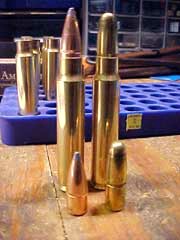
Cases loaded with Hornady 270-grain and 300-grain
bullets.
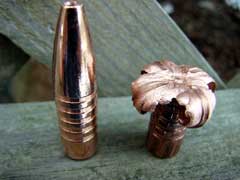
Barnes' 300-grain Triple-Shock bullet mushroomed
perfectly and retained 100% of its weight when fired into test
medium.

Hornady's 300-grain Full Metal Jacket bullets are
designed with a heavy jacket for use on the toughest game on
Earth.
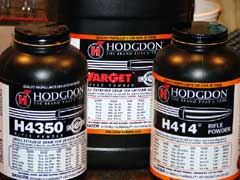
These Hodgdon powders are perfect for the .375 Ruger.
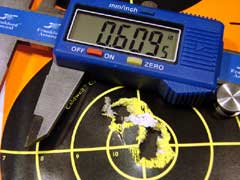
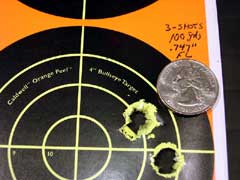
Ruger’s New Hawkeye African .375 Ruger proved to be
superbly accurate, and would be a fine choice for a variety of
hunting applications.
|
![]()